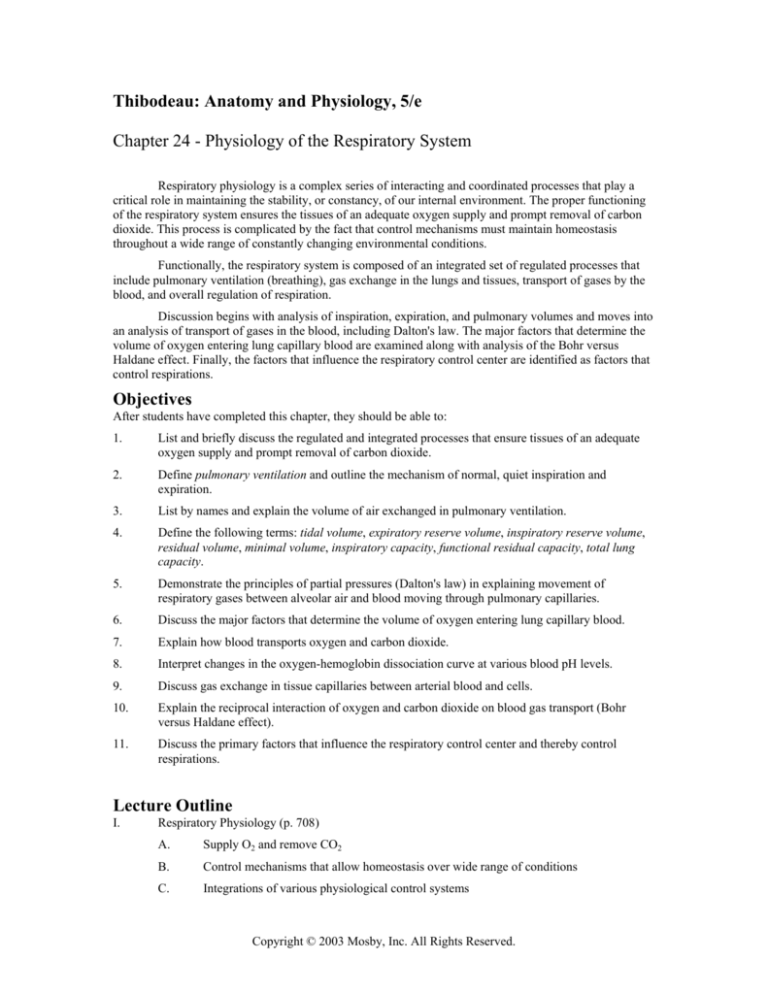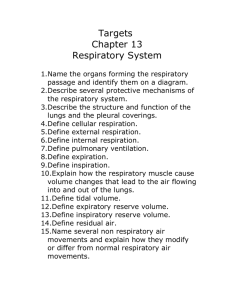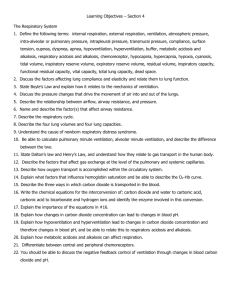
Thibodeau: Anatomy and Physiology, 5/e
Chapter 24 - Physiology of the Respiratory System
Respiratory physiology is a complex series of interacting and coordinated processes that play a
critical role in maintaining the stability, or constancy, of our internal environment. The proper functioning
of the respiratory system ensures the tissues of an adequate oxygen supply and prompt removal of carbon
dioxide. This process is complicated by the fact that control mechanisms must maintain homeostasis
throughout a wide range of constantly changing environmental conditions.
Functionally, the respiratory system is composed of an integrated set of regulated processes that
include pulmonary ventilation (breathing), gas exchange in the lungs and tissues, transport of gases by the
blood, and overall regulation of respiration.
Discussion begins with analysis of inspiration, expiration, and pulmonary volumes and moves into
an analysis of transport of gases in the blood, including Dalton's law. The major factors that determine the
volume of oxygen entering lung capillary blood are examined along with analysis of the Bohr versus
Haldane effect. Finally, the factors that influence the respiratory control center are identified as factors that
control respirations.
Objectives
After students have completed this chapter, they should be able to:
1.
List and briefly discuss the regulated and integrated processes that ensure tissues of an adequate
oxygen supply and prompt removal of carbon dioxide.
2.
Define pulmonary ventilation and outline the mechanism of normal, quiet inspiration and
expiration.
3.
List by names and explain the volume of air exchanged in pulmonary ventilation.
4.
Define the following terms: tidal volume, expiratory reserve volume, inspiratory reserve volume,
residual volume, minimal volume, inspiratory capacity, functional residual capacity, total lung
capacity.
5.
Demonstrate the principles of partial pressures (Dalton's law) in explaining movement of
respiratory gases between alveolar air and blood moving through pulmonary capillaries.
6.
Discuss the major factors that determine the volume of oxygen entering lung capillary blood.
7.
Explain how blood transports oxygen and carbon dioxide.
8.
Interpret changes in the oxygen-hemoglobin dissociation curve at various blood pH levels.
9.
Discuss gas exchange in tissue capillaries between arterial blood and cells.
10.
Explain the reciprocal interaction of oxygen and carbon dioxide on blood gas transport (Bohr
versus Haldane effect).
11.
Discuss the primary factors that influence the respiratory control center and thereby control
respirations.
Lecture Outline
I.
Respiratory Physiology (p. 708)
A.
Supply O2 and remove CO2
B.
Control mechanisms that allow homeostasis over wide range of conditions
C.
Integrations of various physiological control systems
Copyright © 2003 Mosby, Inc. All Rights Reserved.
Chapter 24 - Physiology of the Respiratory System
D.
II.
1.
Acid-base balance
2.
Water balance
3.
Electrolyte balance
4.
Circulation
5.
Metabolism
Integrated set of regulated processes
1.
Pulmonary ventilation (breathing)
2.
Gas exchange in lungs and tissues
3.
Transport of gases by the blood
4.
Overall regulation of respiration
Pulmonary Ventilation (p. 708)
A.
Mechanism of pulmonary ventilation (Fig. 24-1)
1.
Gas pressure gradient
2.
Establishment of pressure gradients
a.
Change in volume of thoracic cavity
b.
Boyle's law states that gas volume varies inversely with
pressure at constant temperature (Box 24-1)
B.
C.
D.
Inspiration (Fig. 24-2)
1.
Diaphragm and external intercostals contract
2.
Sternocleidomastoid, pectoralis minor, and serratus anterior muscles
contract
3.
Volume of thorax increases
4.
Intrapleural (intrathoracic) and intraalveolar pressure decrease
5.
Intrathoracic pressure is less than atmospheric pressure
6.
Air moves into lungs
7.
Elastic recoil tends to return lungs to preinspiration volume
Expiration (Fig. 24-3)
1.
Inspiratory muscles relax
2.
Thorax decreases in size
3.
Intrathoracic pressure increases
4.
Intrathoracic pressure is greater than atmospheric pressure
5.
Air moves out of lungs
6.
Compliance is the ability of the lungs and thorax to stretch
Pulmonary volumes (Fig. 24-5)
1.
Spirometer used for measurement (Fig. 24-4)
2.
Volumes (Table 24-1)
a.
Tidal volume (TV): 500 ml
Copyright © 2003 Mosby, Inc. All Rights Reserved.
2
Chapter 24 - Physiology of the Respiratory System
3.
4.
b.
Expiratory reserve volume (ERV): 1,000–1,200 ml
c.
Inspiratory reserve volume (IRV): 3,000–3,300 ml
d.
Residual volume (RV): 1,200 ml
Capacities (Table 24-1)
a.
Vital capacity (VC): 4,500–5,000 ml
b.
Inspiratory capacity (IC): 3,500–3,800 ml
c.
Functional residual capacity (FRC): 2,200–2,400 ml
d.
Total lung capacity (TLC): 5,700–6,200 ml
Alveolar ventilation
a.
III.
Pulmonary Gas Exchange (p. 716)
A.
Partial pressure (Fig. 24-7)
1.
2.
Law of partial pressure (Dalton's law)
a.
The partial pressure of a gas in a mixture is directly
proportional to the concentration of that gas and the total
pressure of the mixture
b.
Oxygen and carbon dioxide pressure gradients (Table 24-2)
Exchange of gases in the lungs (Fig. 24-8)
a.
Occurs between alveolar air and blood in capillaries
b.
CO2 moves into alveolar air (down its partial pressure
gradient)
c.
O2 moves into blood (down its partial pressure gradient)
d.
Factors influencing oxygen exchange
e.
IV.
Anatomical dead space (Fig. 24-6)
1)
Gradient between alveolar Po2 and blood PO2
2)
Functional surface area of respiratory membrane
3)
Respiratory minute volume
4)
Alveolar ventilation
Structural attributes that facilitate alveolar-blood exchange
1)
Respiratory membrane is very thin
2)
Alveolar and capillary surfaces are very large
3)
Lung capillaries can hold a large amount of blood
4)
Blood layer in capillaries is very thin
How Blood Transports Gases (p. 720)
A.
Hemoglobin (Fig. 24-9, Fig. 24-10)
1.
Four polypeptide chains
2.
Four heme groups
3.
Oxygen binds to heme groups
4.
Carbon dioxide binds to amino acids of polypeptide chains
Copyright © 2003 Mosby, Inc. All Rights Reserved.
3
Chapter 24 - Physiology of the Respiratory System
B.
Transport of oxygen (Fig. 24-8, Fig. 10)
1.
Oxyhemoglobin
a.
2.
3.
About 20.1 ml of dissolved O2/100 ml blood
Oxygen-hemoglobin dissociation curve (Fig. 24-11)
a.
Increased blood PO2 accelerates O2 attaching to hemoglobin
(Hb)
b.
Decreased blood PO2 accelerates O2 dissociation from HbO2
Dissolved in plasma
a.
C.
4
Only about 0.3 ml of dissolved O2/100 ml blood
Transport of carbon dioxide (Fig. 24-15)
1.
Dissolved carbon dioxide (p. 722)
a.
2.
3.
Carried in the plasma; 10% of total carbon dioxide transported
Carbamino compounds (carbaminohemoglobin) (Fig. 24-12)
a.
CO2 carried on an amine group of Hb
b.
Accounts for 20% of CO2 transported
c.
Rate law of chemistry
1)
The rate of the reaction varies with the concentration
of CO2
2)
This gives a carbon dioxide dissociation curve (Fig.
24-13)
Bicarbonate (HCO3–)
a.
Formation (Fig. 24-14)
1)
CO2 and H2O combine to form carbonic acid
(H2CO3)
2)
This reaction occurs in the plasma slowly
3)
In the RBC the enzyme carbonic anhydrase greatly
speeds the reaction; therefore, most of the bicarbonate is
carried in the RBC
4)
b.
Chloride shift
1)
4.
As the carbonic acid is formed, the H+ fraction
combines with Hb, leaving the free bicarbonate ion.
This means that HCO3– concentrations are high in the
cell, so they diffuse out of the cell. As the
bicarbonate diffuses out of the cell, Cl– diffuses into
the RBC. This is called the chloride shift.
Carbon dioxide and pH
a.
V.
About 70% of the CO2 is carried as bicarbonate
Since carbon dioxide and water form carbonic acid, an
increase in carbon dioxide results in increased acidity of the
plasma
Systemic Gas Exchange (Fig. 24-16)
Copyright © 2003 Mosby, Inc. All Rights Reserved.
Chapter 24 - Physiology of the Respiratory System
A.
Gases move down their concentration gradient.
B.
O2 unloading
C.
1.
Oxygen diffuses from arteries to interstitial spaces to cells (where O2
levels are the lowest) (Fig. 24-16)
2.
The arterial blood unloads a varying amount of O2 to the tissues (Fig.
24-17)
VI.
At rest
b.
During exercise
CO2 loading
1.
D.
a.
5
Carbon dioxide diffuses from the cells where it is produced to the
interstitial spaces and then to the veins (Fig. 24-16)
Interaction between PO2 and PCO2 on gas transport (Fig. 24-18)
1.
Increased PCO2 decreases the affinity between Hb and O2; therefore
more O2 will be released; this is called the Bohr effect
2.
Plasma pH becoming more acidic (normally occurs as plasma PCO2
levels rise) also has the same effect of decreasing the affinity between
Hb and O2; this is called the Haldane effect
Regulation of Breathing (p. 727)
A.
Changes in ventilation result in relative constancy of respiratory gases
B.
Found in the brainstem are the respiratory control centers (Fig. 24-19)
1.
Medullary rhythmicity area has two control centers
a.
b.
C.
Inspiratory center
1)
Stimulates inspiratory muscles
2)
Primary respiratory pacemaker
Expiratory center
1)
Stimulates expiratory muscles
2)
Active only when forced expiration is needed
2.
Apneustic center in pons stimulates inspiratory center to cause longer
and deeper breathing
3.
Pneumotaxic center in pons inhibits inspiratory center and apneustic
center, thus preventing overinflation of the lungs
Factors that influence breathing (Figs. 24-20)
1.
Medullary rhymicity area receives feedback from many sources
a.
b.
PCO2 increase stimulates respiration rate increase
1)
Central chemoreceptors (medulla)
2)
Peripheral chemoreceptors (carotid bodies and aorta)
pH decrease stimulates respiration rate increase
1)
c.
Peripheral chemoreceptors (carotid bodies and aorta)
PO2 decrease stimulates respiration rate (emergency only)
Copyright © 2003 Mosby, Inc. All Rights Reserved.
Chapter 24 - Physiology of the Respiratory System
d.
Arterial blood pressure (respiratory pressoreflex) increase
slows respiration
e.
Hering-Breuer reflexes: stretch receptors inhibit inspiration
1)
2.
Cerebral cortex
a.
Motor area
1)
b.
c.
Causes a reflex apnea
Stimulation by irritation of pharynx or larynx
1)
VIII.
Causes a reflex apnea
Sudden cold stimuli
1)
d.
May consciously decide to breathe faster or slower
Painful stimuli
1)
VII.
Prevents overfilling of the lungs
Causes temporary apnea
The Big Picture: Respiratory Physiology and the Whole Body (p. 732)
A.
Provides O2 for, and removes CO2 from, body cells
B.
Circulatory system—gas exchange
C.
Nervous system—respiratory regulation
D.
Muscular system—flow of air
E.
Skeletal system—expansion and contraction of thorax
F.
Immune system—protection of respiratory system
G.
Speech production
H.
pH and CO2 regulation
Mechanisms of Disease: Disorders Associated with Respiratory Function (p. 732)
A.
B.
Restrictive pulmonary disorders
1.
Alveolar fibrosis
2.
Rheumatoid lung
3.
Obesity
4.
Metabolic disorders
Obstructive pulmonary disorders
1.
Chronic obstructive pulmonary disease (COPD)
a.
Bronchitis (Fig. 24-21)
b.
Emphysema (Fig. 24-22)
c.
Asthma (Fig. 24-23)
Copyright © 2003 Mosby, Inc. All Rights Reserved.
6







